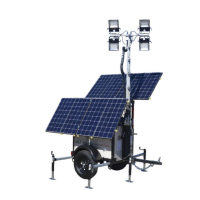17TriStar MPPT Operator’s Manual16 Installation
3.1 General Information
The mounting location is important to the performance and operating life of the controller. The
environment must be dry and protected from water ingress. If required, the controller may be in-
stalled in a ventilated enclosure with sucient air ow. Never install the TriStar MPPT 150V in a
sealed enclosure. The controller may be mounted in an enclosure with sealed batteries, but never
with vented/ooded batteries. Battery fumes from vented batteries will corrode and destroy the
TriStar MPPT 150V circuits.
Multiple TriStars can be installed in parallel on the same battery bank to achieve higher charging cur-
rent. Additional parallel controllers can also be added in the future. Each TriStar MPPT 150V must
have its own solar array.
WARNING: Installation must conform to all requirements of the latest US National
Electrical Code and the Canadian Electrical Code.
AVERTISSEMENT: Installation doit être conforme à toutes les requirments US
National Electrical Code et Code Canadien d’Electricité.
CAUTION: Equipment Damage or Risk of Explosion
Never install the TriStar MPPT 150V in an enclosure with vented/ooded
batteries. Battery fumes are ammable and will corrode and destroy the
TriStar MPPT 150V circuits.
CAUTION: Equipment Damage
When installing the TriStar MPPT 150V in an enclosure, ensure sucient
ventilation. Installation in a sealed enclosure will lead to over-heating and
a decreased product lifetime.
PRUDENCE : Endommagement de l’équipement ou risque
d’explosion
N’installez jamais le TriStar MPPT 150V dans une enceinte avec des
batteries à évent/à électrolyte liquide. Les vapeurs des batteries sont
inammables et corroderont et détruiront les circuits du TriStar MPPT
150V.
PRUDENCE : Endommagement de l’équipement
Assurez une ventilation susante en cas d’installation du TriStar MPPT
150V dans une enceinte. L’installation dans une enceinte hermétique
entraîne une surchaue et une réduction de la durée de vie du produit.
The installation is straight-forward, but it is important each step is done correctly and safely. A
mistake can lead to dangerous voltage and current levels. Be sure to carefully follow each instruction
in this section. Read all instructions rst before beginning installation.
The installation instructions are for installation of a negative grounded system. National Electrical
Code (NEC) requirements are noted on occasion for convenience, however the installer should have
a complete understanding of NEC and UL requirements for photovoltaic installations.
Installation3.0
• Read through the entire installation section rst before beginning installation.
• Be very careful when working with batteries. Wear eye protection. Have fresh water available to
wash and clean any contact with battery acid.
• Use insulated tools and avoid placing metal objects near the batteries.
• Explosive battery gases may be present during charging. Be certain there is sucient ventilation
to release the gases.
• Do not install in locations where water can enter the controller.
• Loose power connections and/or corroded wires may result in resistive connections that melt
wire insulation, burn surrounding materials, or even cause re. Ensure tight connections and use
cable clamps to secure cables and prevent them from swaying in mobile applications.
• Stranded wires to be connected to the terminals should be prepared rst with e.g. clamped
copper heads, tinned-wire ends, etc. to avoid the possibility of one conductor free out of the
connection screw, and possible contact with the metal enclosure.
• Preset charging proles are generally designed for lead acid batteries. Custom settings can be
used for varied charging requirements (see sections 3.2 and 4.2 for details). Note that some
battery types may not be compatible.
• The TriStar MPPT 150V battery connection may be wired to one battery, or a bank of batteries.
The following instructions refer to a singular battery, but it is implied that the battery connection
can be made to either one battery or a group of batteries in a battery bank.
• The TriStar MPPT 150V uses stainless steel fasteners, an anodized aluminum heat sink, and
conformal coating to protect it from harsh conditions. However, for acceptable service life, ex-
treme temperatures and marine environments should be avoided.
• The TriStar MPPT 150V prevents reverse current leakage at night, so a blocking diode is not
required in the system.
• Solar and battery disconnects and overcurrent protection are required in the system.
These protection devices are external to the TriStar MPPT 150V controller. See Section 3.2,
Step 9 - Power Connections - for requirements.
Recommended Tools:
• Wire strippers
• Wire cutters
• #2 & #0 Phillips screwdriver
• slotted screwdrivers
• Pliers
• Drill
• 3/32” (2.5 mm) drill bit
• Level
• hack saw (cutting conduit)

